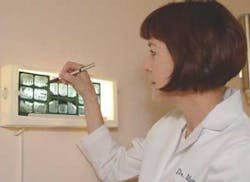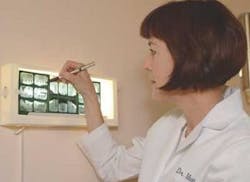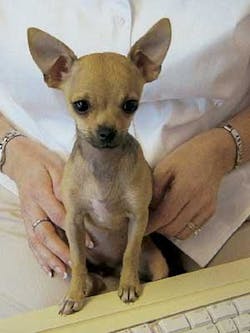Focus on a woman dentist
Carlene A. Mendieta, DDS — Flying high!
We continue our focus on women dentists. This month, WDJ Managing Editor Dr. Margaret Scarlett interviews Dr. Carlene Mendieta, a periodontist in Pinole, Calif.
Dr. Margaret Scarlett — Your airplane trip emulating the transcontinental voyage of Amelia Earhart was an inspiration to many women dentists. What inspired you to perform this historic mission while maintaining your periodontal practice in California?
Dr. Carlene Mendieta — Greg Harris, the owner of the airplane, contacted me to see if I would be interested in recreating the flight. He wanted to create interest in the Golden Age of Aviation by highlighting those key individuals who made aviation a big part of our lives today.
He approached me because I have done almost all of my flying in antique airplanes. For me, it was a dream come true — a chance to fly a trip as closely matched to that one made more than 70 years ago. I admire Amelia Earhart not only for her intellectual abilities and stamina as a pilot, but also for the fact that she did so much in an era when women were tied to the apron strings at home. In the 1920s, women didn't drive or go anywhere unchaperoned, much less fly airplanes! Her flight brought a positive message to women, encouraging them to follow their dreams.
Earhart was a pretty amazing woman — she worked tirelessly for women and young girls. Many of her family members ostracized her because they thought she was not behaving properly. The polite women of society looked upon her as a harlot, because she flew an airplane unescorted and was in the hangars and at the airport working with men.
Earhart set her first record in 1927 as a passenger on an airplane called the Friendship. She was the first woman to cross the Atlantic by airplane. When she made the transcontinental trip in 1928, she was not quite 30-years-old and was the first woman to fly solo round-trip from coast to coast.
I made the trip in a 1927 Avro Avian, a British-made airplane built by the A.V. Roe Company of Manchester, England. While I didn't fly Earhart's specific airplane — it's been lost to history — I did fly its sister ship, which came off the same assembly line two weeks prior. For all practical purposes, it was the same plane. Painted to resemble hers, the plane carried the name "N" (the registration in the United States for aircraft) and the same British registration from England.
When Earhart was in England, she purchased the airplane from Lady Mary Heath, who had set other flying records in that particular airplane, and had the plane shipped home. The airplane is interesting because the wings folded back against the fuselage for easier storage and shipping. At that time, Earhart was staying with the George Putnam family at their estate in Westchester, N.Y., where she wrote her memoirs — a book called Forty-eight hours and Nineteen Minutes — of her trip aboard the Friendship.
While at the Putnam estate, Earhart learned to fly the Avro Avian off the polo fields at the Westchester Country Club. When she completed her book, she planned a vacation to the Los Angeles Air Races in that airplane, with no intention of setting a record. Putnam saw this as a publicity opportunity, so he alerted the press across America that Amelia Earhart was making this trip and that it would be a record if she completed it.
Instead of a vacation, it was a huge publicity fest all the way. Earhart was not very excited about it, but she handled it with aplomb. She hopscotched across the country with no agenda other than to get to the air races. She had several forced landings and a landing accident. She kept a bit of a diary, and, of course, the press wrote about her at each stop. Those newspaper accounts allowed us, decades later, to recreate her trip. We flew her exact timing each day, made the same stops she did, stayed in the same hotels, and landed at the same airfields, many of which are now large, metropolitan airports. We landed at two military bases — Scott AFB and Wright Patterson. They granted us special privilege to land, because civilian aircraft are not normally allowed to land at military airfields.
Earhart had warm welcomes everywhere; she was given keys to cities where she landed. From diary excerpts, we know that she thought it was funny that the women in many towns came out because they thought of her as a big sideshow. They thought she would be some sort of grotesque human being because they believed that no feminine woman would be making this trip. It was always interesting to her that these women were amazed to find out that she was just like them. She was articulate, looked feminine, and was concerned about all the things they were concerned about — clothes, hairdos, family, children, and art.
Many of the old hotels where she stayed have been there since the teens and '20s. We stayed in some grand, wonderful hotels and even met some of the people who greeted Earhart on her trip.
The first person I met was at Hatbox Field in Muskogee, Okla., an old airmail field that has been closed to the public for about 10 years. I met the first person along the trip who had been at that same airfield when Earhart landed — he was a five-year-old boy back then. We met five other people along the way across the United States who had seen Earhart when they were five- to seven-years-old (now they are in their 80s.) I asked each of them to autograph the bottom wing of the plane.
Dr. Scarlett — When did you start flying to get ready for this trip?
Dr. Mendieta — I had about the same number of hours as Amelia Earhart — less than 300 flying hours. Both of us were pretty much novice pilots when we made the trip — that's a very low-time pilot. I almost doubled my hours on that trip.
Dr. Scarlett — You have a successful periodontal practice with a full patient load, practicing three-and-a-half days a week. What made you decide to fly?
Dr. Mendieta — I don't have children, so I have the time. I've always liked flying. I grew up in a small town in Nevada. Cubs and old-time tail-dragger airplanes are plentiful. I always liked it but I had other things to focus on — school, debts. I reached a point in my life when I could afford to fly and felt like I had time to devote to it. So I decided to take lessons and learn to fly in a cub.
Dr. Scarlett — How did your practice support you?
Dr. Mendieta — My staff was totally excited. I notified my colleagues and patients about the trip in a mailing. I included a picture of the airplane and said I hoped they would be supportive. I made them a part of it, and they responded positively. They even gave me a big send-off party. My staff kept everyone informed about what was going on during the trip. I think they enjoyed it almost as much as I did! I am close to my patients too; I consider them my friends. I think that's why they are so supportive of the things I do. My patients are one of my biggest referral sources.
Dr. Scarlett — It wasn't always a piece of cake. 9/11 hit in the middle of the trip, didn't it?
Dr. Mendieta — Yes, I was in a wonderful little town called Hobbs, N.M., visiting Carlsbad Caverns when 9/11 happened. We had planned a week off between the east-to-west and west-to-east trips.
Harris said we had two options: We could stop the trip if I was uncomfortable going on when they reopened the airspace, or we could complete it next year if the weather was bad when they reopened the airspace. He let me choose. While we were very upset that a tragedy such as 9/11 could happen in our country, we also felt strongly that we didn't want it to preempt the flight. We didn't want to be scared away by what happened, so we decided to continue the flight as soon as the airways reopened.
Dr. Scarlett — What was the time sequence?
Dr. Mendieta — We started right after Sept. 1, 2001, and restarted the trip on Sept. 19. Actually, we were right on schedule except for the 9/11 delay. We had planned a week out once we got to Los Angeles. We returned to White Plains, N.Y., on Oct. 5, 2001.
Dr. Scarlett — You videotaped your journey, and you've inspired other women dentists. You've also been a speaker at the American Association of Women Dentists' 81st Annual Meeting.
Dr. Mendieta — I speak to a lot of schools and service organizations. I just did a little segment for a group of young girls in Sonoma County who are vying in an historical essay contest. I try to do what the kids ask me to do, because they're the ones who need inspiration. I also speak to aviation groups and to kids who want to hear about it.
Dr. Scarlett — How long have you been in practice?
Dr. Mendieta — Since 1988. I had been in practice for about 12 years when I decided to learn to fly. In fact, a friend and I are leaving on Saturday morning for Wisconsin so we can fly two planes home.
Dr. Scarlett — What other perspectives can you share with us?
Dr. Mendieta — As soon as you think you can't do something, you need to do it. I have a motto: The best satisfaction in life is doing the things that people think you can't do.
Dr. Scarlett — Did anybody tell you that you couldn't make the Earhart flight?
Dr. Mendieta — Yes, a lot of people. That was an antique airplane. It had been rebuilt and restored, but it doesn't fly particularly well. It flies like a Model A car, with a high chance of engine failure. We also went over some rough territory. Some people thought I was crazy, but you have to follow your heart. You try to minimize the risks as much as possible and then you decide if it is a well-calculated risk. I felt like it was.
Dr. Scarlett — Your decision to fly in an open cockpit plane without other available aviation equipment was novel in itself. I understand you also copied the clothes of the time.
Dr. Mendieta — I love history! The best way to get a feel for aviation in Earhart's time was to duplicate everything as closely as possible. Women flew in specific kinds of clothes — jodhpurs; knee-high, lace-up or slip-on boots; goggles; and helmets — many of which were used for safety. The boots gave protection if you were in a crash and protected against fire. Jodhpurs were big and loose in the seat so they gave you room to move. You need a helmet in an open cockpit airplane like she flew. And the goggles provide eye protection. I had antique goggles, and I was able to find a woman who makes reproduction clothing. She made white cloth flying helmets like the women wore back then. She made me some jodhpurs, styling them after patterns she had from that era. I also found a boot maker who does reproduction boots.
Earhart always wore scarves. Scarves were a fashion statement back then. But what I found is that it wasn't just a fashion statement. I started out wearing a scarf to duplicate her. But it got really cold in Illinois on the return trip and I ended up wrapping it around my neck to stay warm. The scarf certainly has a purpose.
On this trip, I realized that although I loved what I was doing, I missed my practice. I like my patients and my staff. They are an important, warm, fuzzy part of my life. Not only does my practice make me feel competent, it fills up my life. This trip made me realize how much I appreciate the profession. Dentistry gives me the latitude, the money, and the ability to pursue the things I enjoy.
Dr. Scarlett — It sounds like it is a mutually supportive profession for you.
Dr. Mendieta — It is. Dentistry is tough; it takes a lot of energy. It can be rewarding, but it can also be disappointing. I believe that if you run your practice and don't let it run you, it can be very fulfilling. The important thing is that you have to make your practice comfortable for you. You have to make it a place where you want to be. Otherwise, you won't enjoy it.
Dr. Scarlett — You've done that in your practice. Not only did your team members support you through the trip, they are also there for you daily.
Dr. Mendieta — I cannot tell you how supportive my patients and colleagues have been. It concerned me that I would have to be gone for more than a month. We all feel a little uneasy about leaving our practice for long periods of time. But it was a positive experience, because I involved everyone.
Dr. Scarlett — I think this will inspire women dentists. We are hearing from many of them that they're hitting the wall after five years and saying, "Now what?"
Dr. Mendieta — I think that happens a lot. But you have to keep learning; you have to keep expanding. You have to make these things happen. There was a time when I waited for things to happen for me. Then I realized I had to get off my duff and get on with my dream!
My little Chihuahua goes to work with me. That's another one of the best things that I have done. She flies with me and goes to work with me ... she goes everywhere. She's Rosey — she's my girl! Patients love her! She walks around the office checking things out. She sleeps mostly in my office, but she has a little bed up in the front office. She'll come to the back and look up at the chair as if to say, "Hey, what's up?" The other day, one of my patients wanted to hold her. When I came back, she and the dog were both asleep. My patients say that Rosey takes their anxiety away.
To see more of Rosey, visit www.napanet.net/~arbeau/usaah/


